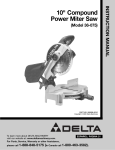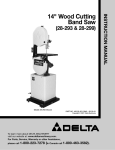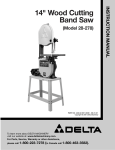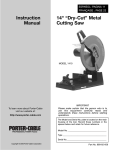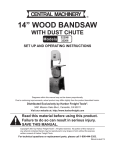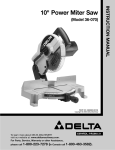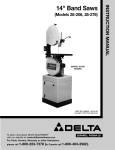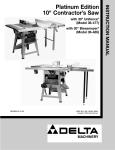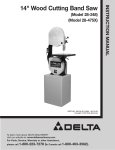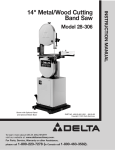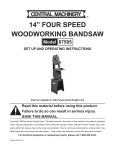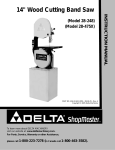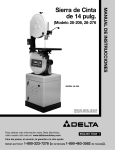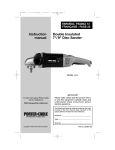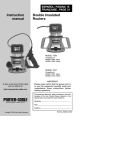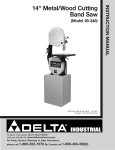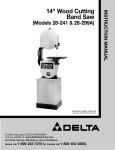Download Delta 28-263 Cordless Saw User Manual
Transcript
(Model 28-263) DATED 4-15-00 PART NO. 426-02-651-0037 Copyright © 2000 Delta Machinery If you have any problems with your new Delta Power Tool, please call us toll free. Have your model and serial numbers ready. FRANÇAIS : PAGE 17 1-800-GO-DELTA (463-3582) INSTRUCTION MANUAL Platinum Edition 14" Band Saw SAFETY RULES Woodworking can be dangerous if safe and proper operating procedures are not followed. As with all machinery, there are certain hazards involved with the operation of the product. Using the machine with respect and caution will considerably lessen the possibility of personal injury. However, if normal safety precautions are overlooked or ignored, personal injury to the operator may result. Safety equipment such as guards, push sticks, hold-downs, featherboards, goggles, dust masks and hearing protection can reduce your potential for injury. But even the best guard won’t make up for poor judgment, carelessness or inattention. Always use common sense and exercise caution in the workshop. If a procedure feels dangerous, don’t try it. Figure out an alternative procedure that feels safer. REMEMBER: Your personal safety is your responsibility. This machine was designed for certain applications only. Delta strongly recommends that this machine not be modified and/or used for any application other than that for which it was designed. If you have any questions relative to a particular application, DO NOT use the machine until you have first contacted Delta to determine if it can or should be performed on the product. Technical Service Manager Delta Machinery 4825 Highway 45 North P. O. Box 2468 Jackson, TN 38302-2468 (In Canada: 505 Southgate Drive, Guelph, Ontario N1H 6M7) WARNING: FAILURE TO FOLLOW THESE RULES MAY RESULT IN SERIOUS PERSONAL INJURY 1. FOR YOUR OWN SAFETY, READ INSTRUCTION MANUAL BEFORE OPERATING THE TOOL. Learn the tool’s application and limitations as well as the specific hazards peculiar to it. 15. MAINTAIN TOOLS IN TOP CONDITION. Keep tools sharp and clean for best and safest performance. Follow instructions for lubricating and changing accessories. 16. DISCONNECT TOOLS before servicing and when changing accessories such as blades, bits, cutters, etc. 2. KEEP GUARDS IN PLACE and in working order. 17. USE RECOMMENDED ACCESSORIES. The use of accessories and attachments not recommended by Delta may cause hazards or risk of injury to persons. 3. ALWAYS WEAR EYE PROTECTION. 4. REMOVE ADJUSTING KEYS AND WRENCHES. Form habit of checking to see that keys and adjusting wrenches are removed from tool before turning it “on.” 18. REDUCE THE RISK OF UNINTENTIONAL STARTING. Make sure switch is in “OFF” position before plugging in power cord. 5. KEEP WORK AREA CLEAN. Cluttered areas and benches invite accidents. 19. NEVER STAND ON TOOL. Serious injury could occur if the tool is tipped or if the cutting tool is accidentally contacted. 6. DON’T USE IN DANGEROUS ENVIRONMENT. Don’t use power tools in damp or wet locations, or expose them to rain. Keep work area well-lighted. 20. CHECK DAMAGED PARTS. Before further use of the tool, a guard or other part that is damaged should be carefully checked to ensure that it will operate properly and perform its intended function – check for alignment of moving parts, binding of moving parts, breakage of parts, mounting, and any other conditions that may affect its operation. A guard or other part that is damaged should be properly repaired or replaced. 7. KEEP CHILDREN AND VISITORS AWAY. All children and visitors should be kept a safe distance from work area. 8. MAKE WORKSHOP CHILDPROOF – with padlocks, master switches, or by removing starter keys. 9. DON’T FORCE TOOL. It will do the job better and be safer at the rate for which it was designed. 21. DIRECTION OF FEED. Feed work into a blade or cutter against the direction of rotation of the blade or cutter only. 10. USE RIGHT TOOL. Don’t force tool or attachment to do a job for which it was not designed. 22. NEVER LEAVE TOOL RUNNING UNATTENDED. TURN POWER OFF. Don’t leave tool until it comes to a complete stop. 11. WEAR PROPER APPAREL. No loose clothing, gloves, neckties, rings, bracelets, or other jewelry to get caught in moving parts. Nonslip footwear is recommended. Wear protective hair covering to contain long hair. 23. DRUGS, ALCOHOL, MEDICATION. Do not operate tool while under the influence of drugs, alcohol or any medication. 12. ALWAYS USE SAFETY GLASSES. Wear safety glasses. Everyday eyeglasses only have impact resistant lenses; they are not safety glasses. Also use face or dust mask if cutting operation is dusty. These safety glasses must conform to ANSI Z87.1 requirements. Note: Approved glasses have Z87 printed or stamped on them. 24. MAKE SURE TOOL IS DISCONNECTED FROM POWER SUPPLY while motor is being mounted, connected or reconnected. 13. SECURE WORK. Use clamps or a vise to hold work when practical. It’s safer than using your hand and frees both hands to operate tool. 25. WARNING: The dust generated by certain woods and wood products can be injurious to your health. Always operate machinery in well ventilated areas and provide for proper dust removal. Use wood dust collection systems whenever possible. 14. DON’T OVERREACH. Keep proper footing and balance at all times. 26. WHEN THE UNIT IS NOT IN USE the switch should be locked in the “OFF” position to prevent unauthorized use. 2 ADDITIONAL SAFETY RULES FOR BAND SAWS 1. ADJUST the upper blade guide about 1/8 above the material being cut. 8. TURN OFF machine if the material is to be backed out of an uncompleted cut. 2. MAKE SURE that blade tension and blade tracking are properly adjusted. 9. MAKE “release” cuts before cutting long curves. 10. ADDITIONAL INFORMATION regarding the safe and proper operation of this product is available from the National Safety Council, 1121 Spring Lake Drive, Itasca, IL 60143-3201 in the Accident Prevention Manual for Industrial Operations and also in the Safety Data Sheets provided by the NSC. Please also refer to the American National Standards Institute ANSI 01.1 Safety Requirements for Woodworking Machinery and the U.S. Department of Labor OSHA 1910.213 Regulations. 3. STOP the machine and wait for the blade to come to a complete stop before removing scrap pieces from the table. 4. ALWAYS keep hands and fingers away from blade. 5. CHECK for proper blade size and type. 6. DO NOT attempt to saw stock that does not have a flat surface, unless a suitable support is used. 11. SAVE THESE INSTRUCTIONS. Refer to them frequently and use them to instruct others. 7. HOLD material firmly and feed into blade at a moderate speed. FOREWORD Delta Model 28-263 Band Saw is designed to give high quality performance with the capacity to cut stock up to 6 1/4 thick x 133/4 wide. It is ideal for contour or straight cutting and resawing operations to cut wood, plastic, building materials, bakelite and non-ferrous metals such as aluminum and copper. Delta Model 28-263 14 Band Saw includes: basic machine with enclosed stand; motor; push button switch; rugged 14 x 14 table that tilts 45° right and 10° left for beveling operations; chip chute; blade and belt guards; arbor, motor pulleys and V-belt; Carter blade guides, and wood cutting blade. UNPACKING AND CLEANING Carefully unpack the band saw and stand from the shipping containers. Remove the protective coating from the machined surfaces of the band saw. This coating may be removed with a soft cloth moistened with kerosene (DO NOT use acetone, gasoline or lacquer thinner for this purpose). After cleaning, cover all un-painted surfaces with a good quality paste wax. ASSEMBLING THE BAND SAW The stand is shipped top down inside the shipping container with the motor mounted to the inside top of the stand. The on/off switch is wired to the end of the power cord. The motor must be removed from the inside top of the stand and reassembled to the horizontal mounting bars inside the stand as follows: A D 1. Remove the stand (A) Fig. 1, from the shipping container being careful not to crimp the switch cord which extends through the top of the stand. NOTE: Set the stand on several blocks of wood to raise the stand off the floor surface. B 2. Remove panel (B) Fig. 1, from stand (A) by removing two screws (C) and loosening two screws (D). Remove panel on opposite side of stand in the same manner. C Fig. 1 3 3. Remove two mounting screws, one of which is shown at (E) Fig. 2, that are holding motor (F) to the top of stand (A). IMPORTANT: DO NOT REMOVE CABLE TIE (G) THAT IS HOLDING SWITCH CORD (H) TO VERTICAL MOUNTING BAR (J), UNLESS YOU ARE USING THE ACCESSORY 28-984 HEIGHT ATTACHMENT ON THE BAND SAW. THIS CABLE TIE (G), WILL KEEP THE SWITCH CORD (H) FROM CONTACTING THE MOTOR PULLEY OR BELT DURING OPERATION. ASSEMBLING MOTOR TO STAND Fig. 2 1. To make the motor assembly easier, turn stand (A) Fig. 3, on its side with two horizontal bars (B) down as shown. 2. Position motor (C) Fig. 3, on two horizontal support bars (B) as shown, and fasten with four 3/4 long carriage bolts, two of which are shown at (D), and four flanged nuts. IMPORTANT: MAKE CERTAIN MOTOR SHAFT (E) IS ON THE SAME SIDE OF THE STAND AS THE LARGE OPENING IN THE TOP OF THE STAND BEFORE TIGHTENING CARRIAGE BOLTS (D). Further motor alignment will be necessary after band saw is fastened to stand. 3. Insert power cord plug (G) Fig. 4, through the bottom hole of the band saw stand. Fig. 3 4. Carefully turn the stand right side up. ASSEMBLING MOTOR PULLEY Assemble motor pulley (A) Fig. 5, to the motor shaft making certain set screw (B) in the motor pulley engages with key (C) in motor shaft. G Fig. 4 A B C Fig. 5 4 ASSEMBLING BAND SAW TO STAND C A B 1. Carefully place the band saw (A) Fig. 6, onto the band saw stand (B). NOTE: Position the band saw so the pulley (C) is over the opening (D) in the stand. E D 2. Align the four holes in the base of the band saw with the four mounting holes in the top of the stand and fasten the band saw to the stand with four 5/16-18 x 13/4 hex head screws, three of which are shown at (E) Fig. 6, with flat washers and flange nuts. E ASSEMBLING AND ALIGNING V-BELT; ADJUSTING BELT TENSION Fig. 6 1. Using a straight edge, align motor pulley (A) Fig. 7, to the driven pulley (B). If necessary, both pulleys can be adjusted inward or outward. The motor (C) can also be adjusted on the motor mounting bars (D). ASSEMBLING BELT AND PULLEY GUARD Assemble belt and pulley guard (A) Fig. 8, to the top of the stand and surrounding the driven pulley with two 3/4-20 x 5/8 hex head screws, flat washers and hex nuts (B). 2. Assemble the V-belt (E) Fig. 7, to pulleys (A) and (B) and adjust the belt tension by raising or lowering the motor (C) on the motor mounting bars (D). If necessary, the motor mounting bars (D) can be repositioned on two vertical posts (F). NOTE: Make certain the pulleys are kept in alignment when doing this. Correct belt tension is obtained when there is approximately 1 deflection, using light finger pressure at the centerspan of the pulleys. B E D Fig. 8 C A F Fig. 7 5 A C D B Fig. 9 Fig. 10 ASSEMBLING SWITCH A 1. MAKE CERTAIN THE BAND SAW IS DISCONNECTED FROM THE POWER SOURCE. 2. CAUTION: THE START/STOP SWITCH-TOMOTOR CORD (F) FIG. 9, IS TIED TO VERTICAL MOUNTING POST (G) OPPOSITE THE MOTOR PULLEY. THIS CABLE TIE (H) PREVENTS THE SWITCHTO-MOTOR CORD (F), FROM CONTACTING THE BELT OR MOTOR PULLEY DURING OPERATION. IMPORTANT: DO NOT REMOVE THIS CABLE TIE UNLESS YOU ARE USING THE ACCESSORY#28-984HEIGHT ATTACHMENT WITH THE BAND SAW. B Fig. 11 3. Remove two outer hex nuts and lock washers (A) Fig. 10, from the two screws extending out from the back of the switch box (B). 4. Insert two screws (C) Fig. 10, located on back of switch box, into two holes (D) located in the band saw arm. 5. Fasten the switch box (B) to the band saw arm using two hex nuts and lockwashers (A) Fig. 11, which were removed in STEP 3. 6. Remove screw and cable clamp (E) Fig. 12, from lower arm of band saw. F 7. Insert switch cord (F) Fig. 12, into clamp (E) which was removed in STEP 6, and fasten switch cord (F) to band saw as shown. IMPORTANT: CHECK AND MAKE CERTAIN THE START/STOP SWITCH-TO-MOTOR CORD (F) FIG. 9, IS NOT CONTACTING MOTOR PULLEY OR BELT. ADJUST CORD (F) FIG. 9, IF NECESSARY, THEN TIGHTEN CABLE TIE (H). E Fig. 12 6 CONNECTING BAND SAW TO POWER SOURCE POWER CONNECTIONS A separate electrical circuit should be used for your tools. This circuit should not be less than #12 wire and should be protected with a 20 Amp fuse. Have a certified electrician replace or repair a worn cord immediately. Before connecting the motor to a power line, make sure the switch is in the “OFF” position and be sure that the electric current is of the same characteristics as stamped on the motor nameplate. Running on low voltage will damage the motor. WARNING: DO NOT EXPOSE THE TOOL TO RAIN OR OPERATE THE TOOL IN DAMP LOCATIONS. MOTOR SPECIFICATIONS Your saw is wired for 115/230 volt, 60 HZ alternating current. Before connecting the saw to the power source, make sure the switch is in the “OFF” position. GROUNDING INSTRUCTIONS This unit should be grounded while in use to protect the operator from electric shock. The unit is equipped with an approved threeconductor cord and three-prong grounding type plug to fit the proper grounding type receptacle. The green (or green and yellow) conductor in the cord is the grounding wire. Never connect the green (or green and yellow) wire to a live terminal. If your unit is for use on less than 150 Volts, the power cord is equipped with a plug that has two flat, parallel current-carrying prongs and one longer, round or “U”-shaped, ground prong which requires a mating 3-conductor grounded-type receptacle, as shown in Fig. 13. An adapter, shown in Fig. 14, is available for connecting 3-prong grounding type plugs that are used on units less than 150 Volts to 2-prong receptacles. THIS ADAPTER IS NOT ALLOWED IN CANADA. The green colored rigid ear, lug, etc., must be connected to a permanent ground such as a properly grounded outlet box, as shown in Fig. 14. GROUNDED OUTLET BOX CURRENT CARRYING PRONGS GROUNDING PRONG IS LONGEST OF THE 3 PRONGS Fig. 13 GROUNDED OUTLET BOX GROUNDING MEANS ADAPTER IN ALL CASES, MAKE SURE THE RECEPTACLE IN QUESTION IS PROPERLY GROUNDED. NEVER REMOVE GROUNDING PRONG FROM POWER PLUG. Fig. 14 7 EXTENSION CORDS Use only three-wire extension cords which have three-prong grounding-type plugs and three-pole receptacle which accept the tool’s plug. Replace damaged or worn cord immediately. DO NOT ATTEMPT TO REPAIR POWER CORD. OPERATING CONTROLS AND ADJUSTMENTS LOCKING SWITCH IN THE “OFF” POSITION STARTING AND STOPPING THE SAW IMPORTANT: When the band saw is not in use, the switch should be locked in the “OFF” position using a padlock (C) Fig. 16, (with 3/16 diameter shackle) through the two holes (D) in the switch plate, as shown in Fig. 16. NOTE: Padlock shown is available as accessory Model 50-325. 1. To start the saw, press the “START” button (A) Fig. 15. 2. To stop the saw, press the “STOP” button (B) Fig. 15. A D B Fig. 16 Fig. 15 8 TABLE INSERT Place table insert (A) Fig. 17, into the hole provided in the table surface, making certain the pin (B) in the table engages one of the indents in the table insert. Fig. 17 TILTING THE TABLE 1. The table on the band saw can be tilted 45 degrees to the right and 10 degrees to the left. To tilt the table to the right, loosen two locking knobs (A) Fig. 18, tilt the table to the desired angle as shown on scale (D), and tighten two locking knobs (A). 2. To tilt the table to the left, loosen two locking knobs (A) Fig. 18, and tilt the table slightly to the right until you can gain access to table stop (B) Fig. 19. Remove table stop (B) Fig. 19, and tilt the table to the left angle up to 10 degrees and tighten two locking knobs (A) Fig. 18. NOTE: Readjust the table stop. (See ADJUSTING TABLE STOP). D A A Fig. 18 ADJUSTING TABLE STOP The band saw is equipped with an adjustable table stop (B) Fig. 19, that allows the table to be set perfectly at 90 degrees with the blade. B C Tilt the table to the left until the table stop (B) Fig. 19, contacts the bottom of the table. Place a square on the table and against the blade as shown in Fig. 20, and check to see if the blade is 90 degrees to the table surface. If an adjustment is necessary, proceed as follows: Fig. 19 1. Tilt the table slightly to the right and tighten table lock knobs. 2. Turn adjustment nut (C) Fig. 19, right or left as necessary to raise or lower table stop (B). 3. Lower the table and make certain the table is 90 degrees to the blade as shown in Fig. 20. 4. It is necessary to remove the adjustable table stop (B) Fig. 19, when tilting the table to the left. Fig. 20 9 ADJUSTING BLADE TENSION DISCONNECT MACHINE FROM POWER SOURCE. On the back of the upper wheel slide bracket, there is a series of graduations. These indicate the proper tension for various widths of blades. With the blade on the wheels, turn the knob (A) Fig. 21, to raise or lower the wheel, until the red fiber washer (B) is in line with the proper graduation for the size of blade being used. The graduations will be found correct for average work, and are not affected by rebrazing of the saw blade. We urge you to use these graduations until you have become familiar enough with the operation of the Band Saw to vary the tension for different kinds of blades or work. OVER-STRAINING IS A COMMON CAUSE OF BLADE BREAKAGE AND OTHER UNSATISFACTORY BLADE PERFORMANCE. RELEASE THE TENSION WHEN THE MACHINE IS NOT IN USE. TRACKING THE BLADE DISCONNECT MACHINE FROM POWER SOURCE. IMPORTANT: Before tracking the blade, make sure the blade guides and blade support bearings are clear of the blade so as not to interfere with the tracking adjustment. After tension has been applied to the blade, rotate the wheels slowly forward by hand and watch the blade (A) Fig. 22, to see that it travels in the center of the upper tire. If the blade begins to creep toward the front edge, loosen the wing nut (B) Fig. 23, and tighten the thumb screw (C). This will tilt the top of the wheel toward the back of the machine and will draw the blade toward the Fig. 21 center of the tire. If the blade creeps toward the back edge, turn the thumb screw in the opposite direction. Adjust the thumb screw (C) Fig. 23, only a fraction of a turn at a time. NEVER TRACK THE BLADE WHILE THE MACHINE IS RUNNING. After the blade is tracking in the center of the tires, tighten the wing nut (B) Fig. 23. C Fig. 23 Fig. 22 10 ADJUSTING UPPER BLADE GUIDE ASSEMBLY DISCONNECT MACHINE FROM POWER SOURCE. The upper blade guide assembly (A) Fig. 24, should always be set as close as possible to the top surface of the material being cut by loosening lock knob (B) and moving the guide assembly (A) to the desired position. B E F ADJUSTING UPPER BLADE GUIDES AND BLADE SUPPORT BEARING C D A Fig. 24 DISCONNECT MACHINE FROM POWER SOURCE. The upper blade guides and blade support bearings are adjusted only after the blade is tensioned and tracking properly. To adjust proceed as follows: 1. The upper blade guides (A) Fig. 24, are held in place by means of the set screws (C) Fig. 24. The upper blade guide guard (D) Fig. 24 is held in place by bolts (E) and set screw (F) Fig. 24. Loosen the set screws (C) to remove the guides for maintenance. A D C 2. The complete upper guide block assembly bracket (A) Fig. 25, can be moved in or out by loosening set screw (B) Fig. 25. The guides (C) Fig. 25, should then be adjusted so that the front edge of the guide roller bearings are just behind the “gullets” of the saw teeth (D) Fig. 25. Be careful not to pinch the blade. B Fig. 25 3. Both upper roller bearing assemblies (A) Fig. 26, can be adjusted by loosening the socket head cap screw (B) Fig. 26. Slide both bearing assembly guides (C) Fig. 26, sideways so the roller bearing outer surface is a couple of thousandths of an inch (about the thickness of a piece of paper) away from the blade. Tighten securely. Be careful not to pinch the blade. D 4. The rear upper blade support bearing (D) Fig. 26, should also be adjusted so it is a couple of thousandths away from the back edge of the blade. The upper blade support bearing, prevents the blade from being pushed too far to the rear which could damage the set in the saw teeth. B A 11 C Fig. 26 ADJUSTING LOWER BLADE GUIDES AND BLADE SUPPORT BEARING B E A D DISCONNECT MACHINE FROM POWER SOURCE. The lower blade guides and lower blade support bearing should be adjusted at the same time as the upper guides and bearing as follows: C F 1. The lower blade guides (A) Fig. 27, are held in place by means of the cap screws (C) Fig. 27. Loosen the cap screws (C) to remove the guides for maintenance. Note: Lower the chip chute out of the way. 2. The complete lower guide block assembly bracket (B) Fig. 27 can be moved in or out by loosening the button head screw (D) Fig. 27. The guides (A) Fig. 27, should then be adjusted so that the front edge of the guide roller bearings are just behind the “gullets” of the saw teeth (F) Fig. 27. Be careful not to pinch the blade. Fig. 27 3. Both lower roller bearing assemblies (C) Fig. 28 can be adjusted by loosening the socket head cap screw (A) Fig. 28. Slide both bearing assembly guides (D) Fig. 28, sideways so the roller bearing outer surface is a couple of thousandths of an inch (about the thickness of a piece of paper) away from the blade. Tighten securely. Be careful not to pinch the blade. A B 4. The rear lower blade support bearing (E) Fig. 27 should also be adjusted so it is a couple of thousandths away from the back edge of the blade. The lower blade support bearing, prevents the blade from being pushed too far to the rear which could damage the set in the saw teeth. E CHIP CHUTE The chip chute (B) Fig. 28 can be equipped with accessories for easy connection to a central exhaust system as shown in (F) Fig. 28 connector and (E) Fig. 28 adapter. (See ACCESSORIES) F Fig. 28 CHANGING THE BLADE MAKE CERTAIN THE MACHINE IS DISCONNECTED FROM THE POWER SOURCE. NOTE: Blades for the 14 band saw are 931/2 in length 1. Open the upper and lower wheel guards. 2. Release tension on the band saw blade. 3. Remove the table adjustment pin and table insert. 4. Slide the saw blade off the wheel and guide it out through the slot in the table. 5. To install the new saw blade, reverse the above procedure. NOTE: Blade teeth should be pointing downward at the front of the table. Fig. 29 12 C D BAND SAW BLADES A band saw blade is a delicate piece of steel that is subjected to tremendous strain. You can obtain long use from a band saw blade if you give it fair treatment. B ensure you use blades of the proper thickness, width, and temper for the various types of material to be cut. Any one of a number of conditions may cause a band saw blade to break. Blade breakage is, in some cases, unavoidable, being the natural result of the peculiar stresses to which such blades are subjected. It is, however, often due to avoidable causes, most often to lack of care or judgment on the part of the operator in mounting or adjusting the blade or guides. The most common causes of blade breakage are: 1) faulty alignments and adjustments of the guides; 2) forcing or twisting a wide blade around a curve of short radius; 3) feeding too fast; 4) dullness of the teeth or absence of sufficient set; 5) excessive tightening of the blade; 6) top guide set too high above the work being cut; 7) using a blade with a lumpy or improperly finished braze or weld; and 8) continuous running of the saw blade when not in use for cutting. Always use the widest blade possible. Use the narrow blades only for sawing small, abrupt curves and for fine delicate work. This will save blades and will produce better work. Band saw blades may be purchased, welded, set and sharpened ready for use. For cutting wood and similar materials, Delta supplies blades in widths of 1 /8, 3/16, 1/4, 3/8, 1/2, and 3/4 inches. File and set the wood cutting blades whenever you find it requires pressure to make them cut. If a blade is broken it can be brazed or welded; however, if it has become badly work-hardened, it will soon break in another place. If you are not equipped to file, set and braze or weld blades, take them to a saw filer for reconditioning. Under average conditions, blades should be resharpened after 4 hours of operation. New blades for the standard 14-inch Band Saw are 931/2 inches long. The adjustment will accommodate blades up to a maximum length of 94 inches and to a minimum length of 911/2 inches. When equipped with the No. 28-984 Height Attachment, new blades should be 105 inches long. The adjustment will accommodate blades up to a maximum length of 106 inches and to a minimum length of 1031/2 inches. OPERATING THE BAND SAW Before starting the machine, see that all adjustments are properly made and the guards are in place. Turn the pulley by hand to make sure that everything is correct BEFORE turning on the power. KEEP THE SAW BLADE SHARP and you will find that very little forward pressure is required for average cutting. Move the stock against the blade steadily and no faster than will give an easy cutting movement. Keep the top guide down close to the work at all times. Do not force the material against the blade too hard. Avoid twisting the blade by trying to turn sharp corners. Remember, you must saw around corners. Light contact with the blade will permit easier following of the line and prevent undue friction, heating, and workhardening of the blade at its back edge. CUTTING CURVES When cutting curves, turn the stock carefully so that the blade may follow without being twisted. If a curve is so abrupt that it is necessary to repeatedly back up and cut a new kerf, either a narrow blade is needed or a blade with more set is required. The more set a blade has, the easier it will allow the stock to be turned, but the cut is usually rougher than where a medium amount of set is used. In withdrawing the piece being cut, in order to change the cut, or for any other reason, the operator must be careful that he does not accidentally draw the blade off the wheels. In most cases it is easier and safer to turn the stock and saw out through the waste material, rather than try to withdraw the stock from the blade. 13 ACCESSORIES The testing of this unit has been accomplished with the following accessories. For safest operation, it is recommended that only these accessories be used with this unit. WARNING: Since accessories other than those listed have not been tested with this unit, use of such accessories could be hazardous. 50-484 49-220 28-198 50-325 28-984 28-855 50-274 Connector Hose Adapter Carter Guide Assembly Padlock Height Attachment Rip Fence Mobile Base 14² BAND SAW HIGH CARBON STEEL BLADES for Wood, Plastics, Compositions and Non-Ferrous Metal Cat. Number Width 28-032 28-033 28-034 28-036 28-038 28-040 28-045 28-046 28-047 28-048 28-050 28-052 1/8 Length Min. Cut Radius 1/2 93 931/2 931/2 931/2 931/2 931/2 105 105 105 105 105 105 3/16 1/4 3/8 1/2 3/4 1/8 3/16 1/4 3/8 1/2 3/4 Teeth per Inch 3/16 14 6 6 6 6 4 14 6 6 6 6 4 5/16 5/8 13/8 21/2 51/2 3/16 5/16 5/8 13/8 21/2 51/2 14² BAND SAW DELTA PLATINUM PRO® BLADES for Wood, Plastics, Compositions and Non-Ferrous Metal Cat. Number 28-963 28-964 28-965 28-966 28-959 28-960 Width 3/16 1/4 3/8 1/2 3/8 1/2 Length Min. Cut Radius 931/2 931/2 931/2 931/2 105 105 5/16 5/8 13/8 21/2 13/8 21/2 Teeth per Inch 6 6 6 6 6 4 14² BAND SAW HIGH CARBON STEEL SKIP TOOTH BLADES for Wood, Aluminum, Magnesium, Plastics and Compositions Cat. Number 28-884 28-885 28-886 Width 1/4 3/8 1/2 Length Min. Cut Radius 931/2 931/2 931/2 5/8 3/8 1 21/2 14 Teeth per Inch 6 4 4 DELTA/PORTER-CABLE GUARANTEE GARANTIE DELTA/PORTER-CABLE Delta is proud of the quality power tools it sells. The component parts of our tools are inspected at various stages of production and each finished tool is subjected to a final check before being packaged for shipment. Because of our confidence in our engineering quality, Delta agrees to repair or replace any part or parts of Delta/Porter-Cable Power Tools and accessories which examination proves to be defective in workmanship or material. The warranty period for Delta brand is two years, for Porter-Cable, one year. Any alleged defective part or parts must be returned prepaid to the Delta factory or one of the service centres. The guarantee does not include repair labour or parts replacement required because of misuse, abuse, or normal wear and tear. Repairs made by other than our factory, Delta service centre or authorized service station relieve Delta of further liability under this guarantee. THIS GUARANTEE IS MADE EXPRESSLY IN PLACE OF ALL OTHER GUARANTEES OR WARRANTIES, EXPRESSED OR IMPLIED, WITH RESPECT TO QUALITY, MERCHANTABILITY, OR FITNESS FOR A PARTICULAR PURPOSE. Delta est fière de la qualité des outils électriques qu’elle met sur le marché. Leurs composants sont inspectés à chaque étape de la fabrication, et chaque outil subit une dernière vérification avant d’être emballé pour l’envoi. Pour confirmer l’entière confiance de Delta dans la qualité technique de ses produits, la compagnie s’engage à réparer ou à remplacer tout élément ou accessoire d’un outil électrique Delta/Porter-Cable présentant un défaut dûment reconnu de matière ou de fabrication. La garantie est d’une durée de deux (2) ans pour les articles de la marque Delta et d’un an pour les PorterCable. La ou les pièces présumées défectueuses doivent être renvoyées franco de port à l’usine ou à l’un des centres de service de l’usine Delta. La garantie ne comprend pas les frais de main-d’oeuvre ou de remplacement, de pièce, occasionnés par suite de mauvais usage, dégradation et usure normale, lesquels ne donnent droit ni à remplacement, ni à réparation. Toute réparation effectuée en dehors de notre usine, de nos succursales de service et de nos centres de service autorisés annule la garantie. IL EST EXPRESSÉMENT PRÉCISÉ QUE NOUS NE SERONS ENGAGÉS PAR AUCUNE AUTRE GARANTIE (EXPRESSE OU TACITE) DE QUALITÉ INTRINSÈQUE, DE QUALITÉ MARCHANDE OU D’APTITUDE À UN EMPLOI PARTICULIER. Printed in U.S.A. 15 PORTER-CABLE • DELTA SERVICE CENTERS (CENTROS DE SERVICIO DE PORTER-CABLE • DELTA) Parts and Repair Service for Porter-Cable•Delta Power Tools are Available at These Locations (Obtenga Refaccion de Partes o Servicio para su Herramienta en los Siguientes Centros de Porter-Cable•Delta) ARIZONA Tempe 85282 (Phoenix) 2400 West Southern Avenue Suite 105 Phone: (602) 437-1200 Fax: (602) 437-2200 CALIFORNIA Ontario 91761 (Los Angeles) 3949A East Guasti Road Phone: (909) 390-5555 Fax: (909) 390-5554 San Leandro 94577 (Oakland) 3039 Teagarden Street Phone: (510) 357-9762 Fax: (510) 357-7939 COLORADO Denver 80216 5855 Stapleton Drive North Suite A-140 Phone: (303) 370-6909 Fax: (303) 370-6969 FLORIDA Davie 33314 (Miami) 4343 South State Rd. 7 (441) Unit #107 Phone: (954) 321-6635 Fax: (954) 321-6638 ILLINOIS Addison 60101 (Chicago) 311 Laura Drive Phone: (630) 628-6100 Fax: (630) 628-0023 Woodridge 60517 (Chicago) 2033 West 75th Street Phone: (630) 910-9200 Fax: (630) 910-0360 MARYLAND Elkridge 21075 (Baltimore) 7397-102 Washington Blvd. Phone: (410) 799-9394 Fax: (410) 799-9398 MASSACHUSETTS Braintree 02185 (Boston) 719 Granite Street Phone: (781) 848-9810 Fax: (781) 848-6759 Franklin 02038 (Boston) Franklin Industrial Park 101E Constitution Blvd. Phone: (508) 520-8802 Fax: (508) 528-8089 Tampa 33609 4538 W. Kennedy Boulevard Phone: (813) 877-9585 Fax: (813) 289-7948 MICHIGAN Troy 48083 (Detroit) 1355 Combermere Phone: (248) 597-5000 Fax: (248) 597-5004 GEORGIA Forest Park 30297 (Atlanta) 5442 Frontage Road, Suite 112 Phone: (404) 608-0006 Fax: (404) 608-1123 MINNESOTA Minneapolis 55429 4315 68th Avenue North Phone: (612) 561-9080 Fax: (612) 561-0653 MISSOURI North Kansas City 64116 1141 Swift Avenue P.O. Box 12393 Phone: (816) 221-2070 Fax: (816) 221-2897 OREGON Portland 97230 4916 NE 122 nd Ave. Phone: (503) 252-0107 Fax: (503) 252-2123 St. Louis 63119 7574 Watson Road Phone: (314) 968-8950 Fax: (314) 968-2790 PENNSYLVANIA Willow Grove 19090 520 North York Road Phone: (215) 658-1430 Fax: (215) 658-1433 NEW YORK Flushing 11365-1595 (N.Y.C.) 175-25 Horace Harding Expwy. Phone: (718) 225-2040 Fax: (718) 423-9619 NORTH CAROLINA Charlotte 28209 4303-B South Boulevard Phone: (704) 525-4410 Fax: (704) 525-0618 OHIO Columbus 43214 4560 Indianola Avenue Phone: (614) 263-0929 Fax: (614) 263-1238 Cleveland 44125 8001 Sweet Valley Drive Unit #19 Phone: (216) 447-9030 Fax: (216) 447-3097 TENNESSEE Nashville 37214 2262 Lebanon Pike Phone: (615) 882-0320 Fax: (615) 882-0051 TEXAS Dallas 75220 10720 N. Stemmons Freeway Phone: (214) 353-2996 Fax: (214) 350-3943 Houston 77055 West 10 Business Center 1008 Wirt Road, Suite 120 Phone: (713) 682-0334 Fax: (713) 682-4867 WASHINGTON Renton 98055 (Seattle) 268 Southwest 43rd Street Phone: (425) 251-6680 Fax: (425) 251-9337 Authorized Service Stations are located in many large cities. Telephone 800-487-8665 or 901-541-6042 for assistance locating one. Parts and accessories for Porter-Cable •Delta products should be obtained by contacting any Porter-Cable•Delta Distributor, Authorized Service Center, or Porter-Cable•Delta Factory Service Center. If you do not have access to any of these, call 888-848-5175 and you will be directed to the nearest Porter-Cable•Delta Factory Service Center. Las Estaciones de Servicio Autorizadas están ubicadas en muchas grandes ciudades. Llame al 800-487-8665 ó al 901-541-6042 para obtener asistencia a fin de localizar una. Las piezas y los accesorios para los productos Porter-Cable•Delta deben obtenerse poniéndose en contacto con cualquier distribuidor Porter-Cable•Delta, Centro de Servicio Autorizado o Centro de Servicio de Fábrica Porter-Cable•Delta. Si no tiene acceso a ninguna de estas opciones, llame al 888-848-5175 y le dirigirán al Centro de Servicio de Fábrica Porter-Cable•Delta más cercano. PORTER-CABLE • DELTA SERVICE CENTERS ALBERTA Bay 6, 2520-23rd St. N.E. Calgary, Alberta T2E 8L2 Phone: (403) 735-6166 Fax: (403) 735-6144 BRITISH COLUMBIA 8520 Baxter Place Burnaby, B.C. V5A 4T8 Phone: (604) 420-0102 Fax: (604) 420-3522 MANITOBA 1699 Dublin Avenue Winnipeg, Manitoba R3H 0H2 Phone: (204) 633-9259 Fax: (204) 632-1976 ONTARIO 505 Southgate Drive Guelph, Ontario N1H 6M7 Phone: (519) 836-2840 Fax: (519) 767-4131 QUÉBEC 1515 ave. St-Jean Baptiste, Québec, Québec G2E 5E2 Phone: (418) 877-7112 Fax: (418) 877-7123 1447, Begin St-Laurent, (Montréal), Québec H4R 1V8 Phone: (514) 336-8772 Fax: (514) 336-3505 The following are trademarks of PORTER-CABLE•DELTA Corporation (Las siguientes son marcas registradas de PORTER-CABLE S.A.): BAMMER®, INNOVATION THAT WORKS®, JETSTREAM®, LASERLOC®, OMNIJIG®, POCKET CUTTER®, PORTA-BAND®, PORTA-PLANE®, PORTER-CABLE®, QUICKSAND®, SANDTRAP®, SAW BOSS®, SPEED-BLOC®, SPEEDMATIC®, SPEEDTRONIC®, STAIR-EASE®, THE PROFESSIONAL EDGE®, THE PROFESSIONAL SELECT®, TIGER CUB®, TIGER SAW®, TORQBUSTER®, WHISPER SERIES®, DURATRONIC™, FLEX™, FRAME SAW™, MICRO-SET™, MORTEN™, NETWORK™, RIPTIDE™, TRU-MATCH™, WOODWORKER’S CHOICE™. Trademarks noted with ® are registered in the United States Patent and Trademark Office and may also be registered in other countries. Las Marcas Registradas con el signo de ® son registradas por la Oficina de Registros y Patentes de los Estados Unidos y también pueden estar registradas en otros países. Printed in U.S.A.

















